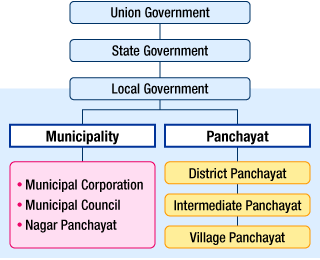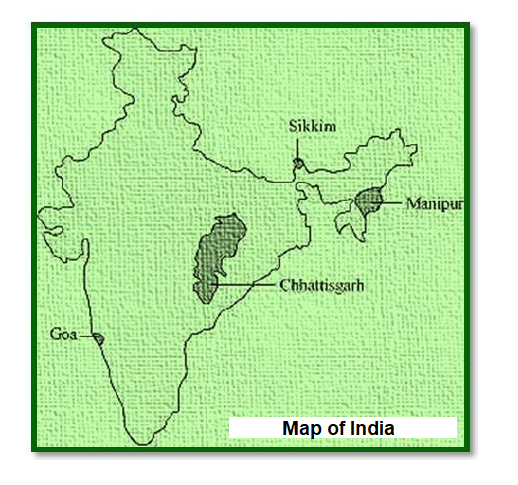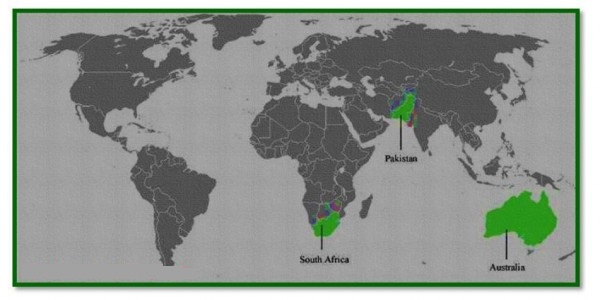Federalism Class 10 Notes is a vital resource for students to grasp the structure and dynamics of government systems. This topic delves into the principles of power-sharing and governance, providing students with insights into the workings of democratic systems worldwide. Chapter 2 of Civics in the Class 10 Social Science curriculum focuses on Federalism, its defining features, various forms, and its role in shaping Indian democracy.
This comprehensive guide on Federalism Class 10 Notes simplifies these concepts with examples, tables, and diagrams, ensuring clarity and making it easier for students to ace their exams.
This Blog Includes:
- What is Federalism?
- Objectives of Federalism
- Types of Federalism
- Difference Between a Unitary System and a Federal System
- Key Features of Federalism
- Formation of Federations
- What Makes India a Federal Country?
- How is Federalism Practised in India?
- Decentralisation in India: Power for Local Governments
- Panchayati Raj: What is it and How Does it Work?
- Municipalities
- What Makes India a Federal Country Class 10 PDF Download
- Important Questions & Answers
- Examples of federal Counties
- Federalism Class 10 MCQs
- FAQs
What is Federalism?
To put it simply, Federalism can be referred to as a form of government that comprises a division of power between the central authority and several other units of government, such as states. While studying our Federalism Class 10 notes, you must also go through the prominent levels of government in a nation, following this concept.
In a federal country, there are two significant government levels, and each enjoys multiple powers that are independent of the other. These two levels of the federal government are:
- The central government is responsible for handling issues that concern the entire nation.
- The state governments look after the day-to-day administration of individual states/provinces.
Objectives of Federalism
The next concept you must explore through our Federalism class 10 notes is the objectives of Federalism. The main objectives of federalism are to ensure power-sharing, promote national unity, protect regional interests, and strengthen democratic governance. It aims to balance the authority of the central government with the autonomy of states, creating harmony in diverse societies, which are as follows:
- To advance and protect the unity of a nation.
- To support regional diversity in a country.
- To provide a constitutional mechanism for resolving disputes between central and state governments.
- To ensure that resources and opportunities are shared fairly, encourage growth across all regions.
Also Read: Which is a federal division of power
Types of Federalism
Different countries adopt different models of federalism depending on their history, culture, and social needs. Each type reflects how power and responsibilities are shared between the central and state governments. Here are the different types of federalism:
- Dual Federalism: Also known as the Layer Cake Model, this form of federalism has a clear and strict separation of powers between the central and state governments. Each level of government functions independently in its own sphere without interfering in the other’s domain.
- Cooperative federalism: Often referred to as the marble cake model, here both levels of government work together to achieve common goals like development, poverty reduction, and welfare programs. Instead of a strict division, responsibilities overlap, encouraging collaboration.
- Competitive federalism: In this model, states or provinces compete with each other to attract investment, industries, and development projects. It motivates the government to improve governance infrastructure and service for the benefit of citizens.
- Asymmetrical Federalism: This type of federalism exists when some states or regions are granted more powers and autonomy compared to others due to cultural, historical, or geographical reasons. It ensures that the special needs of certain regions are addressed without disturbing the unity of the nation.
Difference Between a Unitary System and a Federal System
The class 10 chapter on Federalism also notes that there is a crucial difference between the unitary system of government and the federal system of government. Take a look at the major differences between these two systems of government:
| Unitary System | Federal System |
| In this system, the government’s powers are centralized. If there are sub-units under the central government, they are under the control of the center. | There are two or more tiers of government that function independently. |
| The center can pass orders or commands to the sub-units. | The center cannot issue commands to the state governments. |
| The central government is supreme and can narrow or broaden the powers of the sub-units. | The state governments function independently and are not answerable to the center. |
Key Features of Federalism
The key features of federalism highlight how power is shared between different levels of government. These include a clear division of powers, supremacy of the constitution, an independent judiciary, and the existence of multiple levels of government working within their own jurisdictions.
While summarising this chapter of Class 10 Social Science, you must also prepare the study notes on the salient features of Federalism, which are listed below:
- Two or More Levels of Government: Federalism operates with at least two levels of government, one is central and another is regional (state/provincial).
- Constitutional Distribution of Powers: The Constitution clearly defines the powers and responsibilities of each level of government. Both central and state governments govern the same set of citizens, but the level has varying powers in some issues like administration, taxation, and legislation.
- Mutual Agreement for Constitutional Changes: Any single tier of government does not hold the authority to change or alter the fundamental powers of the constitution of a federal country (unilaterally), but an agreement will be needed from both sides to modify any such fundamental power or right.
- Independent Judiciary: The courts have the authority to interpret the powers of different government tiers to ensure that they don’t change the Constitution.
- Revenue Sharing: The constitution specifies sources of revenue for both levels of government. This ensures the financial autonomy of both tiers.
Formation of Federations
The next sub-topic we have summarised in our Federalism Class 10 notes is the methods by which federations are formed. To ensure the success of federations, there need to be two critical factors: mutual trust between the different government tiers and a willingness to live together. Historically, federations have been formed in two different ways:
- Independent states are coming together on their own accord to form a bigger country. This type of federation was established in Australia, Switzerland, and the USA.
- A large country decides to divide power between the national government and constituent states. Examples of this type of federation include India, Belgium, and Spain.
What Makes India a Federal Country?
A crucial question asked in this chapter on Federalism in Class 10 Social Science is what makes India a federal country. As per the Indian Constitution, the nation follows a three-fold distribution of legislative powers.
The distribution of powers between the union and state governments is what makes India a federal country. In India, there are three lists divided between the centre and state governments, i.e.
- Union List: It includes areas of national importance like defence, foreign affairs, currency, banking, and communications. The union government holds the power to make laws on the regions mentioned in the union list.
- State List: It includes areas of state-level and local importance like agriculture, trade, commerce, irrigation, and police. The state government alone has the power to make laws regarding the subjects on this list.
- Concurrent List: It includes subjects that are of common interest to both the central and state governments. It includes trade unions, forests, education, marriage, succession, and adoption. Both the centre and state can make laws on these subjects. If there is a conflict, the laws made by the centre will prevail.
How is Federalism Practised in India?
Another important section covered under the study notes for Federalism in Class 10 Social Science is how it is practised in India. Here are some of the challenges to how federalism is exercised in the country.
- Formation of Linguistic States: From the time of independence, several new states have been formed in India. A vast majority of India’s states are created to include people who speak the same language and belong to the same region. These states are known as linguistic states. Examples include Tamil Nadu, Kerala, Karnataka, etc.
- Language Policy: Besides Hindi, 21 languages are recognised by the Constitution as Scheduled Languages. Though Hindi is recognised as the official language by the union government, states have their own official language. Government work in countries takes place in the official language of the state.
- Centre-state Relations: If no single party gets a majority in the Lok Sabha elections, major national parties ally with regional parties to form the union government. This led to the practice of power-sharing between the centre and states while respecting state governments’ autonomy.
Decentralisation in India: Power for Local Governments
The Class 10 chapter on Federalism also elaborates on the essential aspects of decentralisation, which plays a key role in empowering local government. The practice of taking power away from the union and state governments and giving it to local governments is called decentralisation.
The objective behind devolution is that most issues and problems can be resolved better at the local level. This way, local citizens can directly participate in decision-making. In 1992, the constitution was amended to make way for a third tier of democracy. The key features of the third tier, as per the constitution, are:

- Periodic elections must be held mandatorily to fill positions in the various local government bodies.
- One-third of all local government positions are reserved for women.
- The State Election Commission was created in each state to hold municipal and Panchayat-level elections.
- A percentage of the positions of executive heads in local elections is reserved for SC, ST, and other backwards classes.
- State governments are required to share revenue and powers with local government bodies. The percentage of revenue sharing varies from state to state.
Also Read: What are the various aspects of democracy
Panchayati Raj: What is it and How Does it Work?
While studying our Class 10 Federalism notes, you must also understand the participation of the Panchayati Raj in the functioning of the Federal Indian government. Panchayati Raj is the term given to rural governments in India. These are local governments, and each village has a setup known as a Gram Panchayat.
- The Gram Panchayat is a council that includes several local members known as panch and a president known as sarpanch. The panch and sarpanch are elected by the adults of the village/ward. The Gram Panchayat is responsible for making decisions for the entire village.
- The Gram Sabha supervises the Panchayat. All adults of voting age in a village form the Gram Sabha. The Gram Sabha meets at least twice or thrice a year to approve the Panchayat budget and review its performance.
- Several Gram Panchayats are clubbed together to form a Panchayat Samiti, Mandal, or Block. All Panchayat members in a region elect the members of the Panchayat Samiti.
- The Panchayat Samitis in a district are grouped to form the Zilla Parishad. MLAs of the areas, MPs of the district, and other district-level officials constitute the Zilla Parishad.
Municipalities
Just like Gram Panchayats work in rural areas, municipalities are responsible for the urban regions. Big cities have municipal corporations. Elected bodies of representatives control municipal corporations and municipalities – like MPs, MLAs, councillors, etc. The political head of the municipality is the Municipal Chairperson. The head of a municipal corporation is the Mayor.
The system of a decentralised local government is the biggest democracy experiment in the world. Local governments have helped in strengthening the functioning of democracy in India while supporting women and citizens belonging to SC/ST and other backwards classes to gain a voice in the democratic process.
What Makes India a Federal Country Class 10 PDF Download
Class 10 students delve into the concept of federalism to see how it strengthens India’s democracy by embracing diversity and fostering cooperative governance. Download the What Makes India a Federal Country Class 10 PDF for detailed notes, examples, and explanations designed to help students master this vital topic with ease.
Important Questions & Answers
Now that you are familiar with the major concepts of Federalism and how it is practised in India, take a look at the important exam questions you must prepare for the Federalism Class 10 Social Science exam:
Identify the following states on a blank political map of India: Chhattisgarh, Goa, Manipur, and Sikkim.
Sol:

Identify any three federal countries in the world (other than India). Shade them on a blank political world map.
Sol:

State the differences between a federal government and a unitary government.
Sol:
| Federal Government | Unitary Government |
| There is power-sharing between the union and state governments. | The power is under the control of the union government, and there is no role for state governments. |
| There is power-sharing between the union and state governments. | Example: Sri Lanka(The national government enjoys all the powers) |
What are the prominent features of Federalism?
Sol: The Following are the salient features of Federalism:
- The power is distributed among the executive, judiciary, and legislative.
- The national government shares powers with the provincial governments.
- Government power is divided between different levels of government
- Elected officials exercise supreme power in the government.
Describe the key factors of how Federalism is practised in India.
Sol: The key factors of how Federalism Class 10 notes are practised in India are based on:
Formation of Linguistic States
From the time of independence, several new states have been formed in India. A vast majority of India’s states are created to include people who speak the same language and belong to the same region. These states are known as linguistic states. Examples include Tamil Nadu, Kerala, Karnataka, etc.
Language Policy
Besides Hindi, 21 languages are recognised by the Constitution as Scheduled Languages. Though Hindi is recognised as the official language by the Union government, states have their own official language. Government work in countries takes place in the official language of the state.
Center-state Relations
If no single party gets a majority in the Lok Sabha elections, major national parties ally with regional parties to form the union government. This led to the practice of power-sharing between the centre and states while respecting state governments’ autonomy.
Examples of federal Counties
Federal countries are nations where power is divided between a central government and regional or state governments. This system allows them to maintain unity while respecting regional diversity. Some well-known examples include India, the USA, Canada, Australia, and Brazil. Here are some examples of federal countries:
- India
- United States of America (USA)
- Canada
- Australia
- Brazil
Also Read: What Are the Factors Responsible for the Success
Federalism Class 10 MCQs
MCQs on Federalism help students test their understanding of concepts like power-sharing, features of federalism, division of powers, and India’s federal structure. Practising these questions is useful for quick revision and scoring well in Class 10 exams.
Here is an MCQ test for Class 10 Federalism:
1. Select the most common form of power-sharing in Federalism
| a. Vertical Division of Power | b. Horizontal Division of Power |
| c. Power sharing in political parties | d. Power of division in communities |
2. Name the schedule in the Indian Constitution where the 22 scheduled languages are provided.
| a. 6th Schedule | b. 7th Schedule |
| c. 8th Schedule | d. 9th Schedule |
3. Name the authority in India which organises elections for Municipalities and Panchayats.
| a. Parliament | b. Local government |
| c. Election Commission | d. State Election Commission |
4. The third tier of the government is referred to as:
| a. Municipalities | b. State Governments |
| c. District | d. Local Self-Government |
5. What are the salient objectives of the Federal System:
| a. To protect and foster unity in a nation | b. Both a and c |
| c. To support regional diversity in a country | d. To administer the governments at different levels |
Answers:
- a.
- c.
- d.
- d.
- b.
FAQs
Ans: Federalism is a form of governance in which a central authority and numerous national component parts share power
Ans: The Gram Panchayat at the village level, Panchayat Samiti at the block level, and Zila Parishad at the district level make up the Panchayati Raj system.
Ans: Robert Garan, an Australian scholar, gave the definition of federalism.
Ans: Johannes Althusius, a German intellectual, is the father of modern federalism.
Ans: Mutual trust between various levels of the government and consensus to live together are required for the formation of a federal government. Federations can be formed by independent units grouping together to form a larger government. For example, Australia and the USA. Another way is when a large country chooses to divide its powers between the states and constituent national governments. For example, India and Spain.
Ans: Two or more tiers of government, constitutional superiority, a separate judiciary, and the supreme authority of the courts are some of the key features of federalism explained in class 10, chapter 2.
Ans: Although India is a federal nation, the term has never been used in the constitution. In fact, India is known as a quasi-federal country. The country is a ‘Union of States’. India has features of a federal government. That is, it has 3 levels of government: the central government, the state government, and the local government.
Ans: Federalism is a system of government where power is divided between a central authority and various constituent units of the country. It ensures decentralised governance, promoting unity while allowing regional diversity.
Ans: In India, Federalism operates with a three-tier system: Union, State, and Local governments. The Constitution divides powers into Union, State, and Concurrent Lists, ensuring a clear distribution of responsibilities.
Ans: While both countries follow Federalism, the USA practices dual federalism with strong state autonomy. India follows cooperative federalism, where the central government has more authority, ensuring unity in diversity.
Ans: Local governments, like Panchayats and Municipalities, ensure local administration, participation in governance, and efficient implementation of policies, as mandated by the Constitution.
Ans: Countries like the United States, India, Australia, Canada, and Germany follow Federalism. Each has distinct systems but shares the principle of power division.
Related Read
Thus, we hope that our Federalism Class 10 notes help you understand the key concepts explored in this chapter. Unsure about the right stream after the 10th? Get in touch with our Leverage Edu experts, and we will assist you in selecting the best stream of study as per your interests and preferences. Sign up for a free session with us today! Call us immediately at 1800 57 2000 for a free 30-minute counselling session.
-
Great
-
Hey! Thank you for your feedback.
-
-
I like this website

 One app for all your study abroad needs
One app for all your study abroad needs





















 60,000+ students trusted us with their dreams. Take the first step today!
60,000+ students trusted us with their dreams. Take the first step today!


4 comments
Great
Hey! Thank you for your feedback.
I like this website
Nice